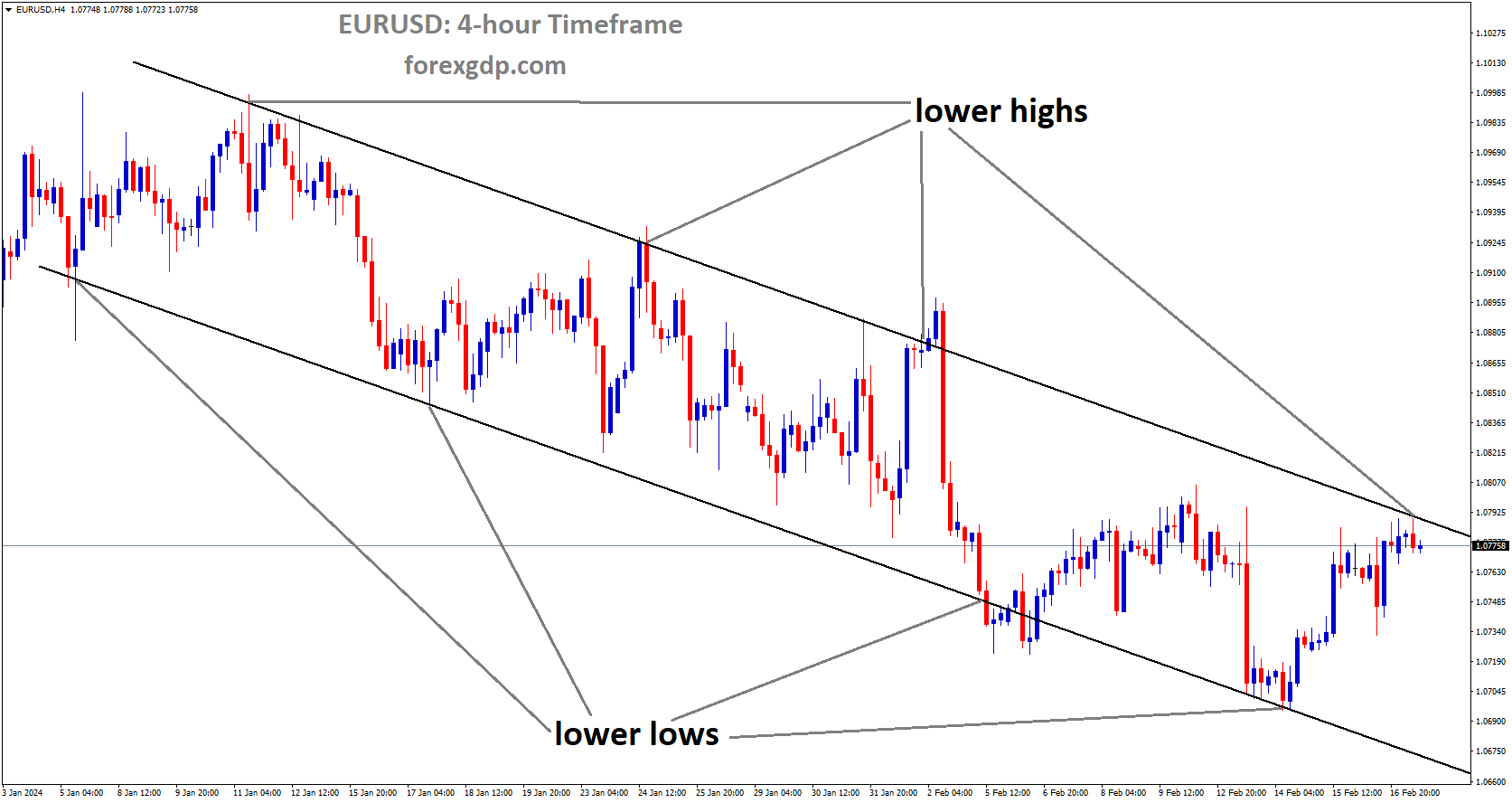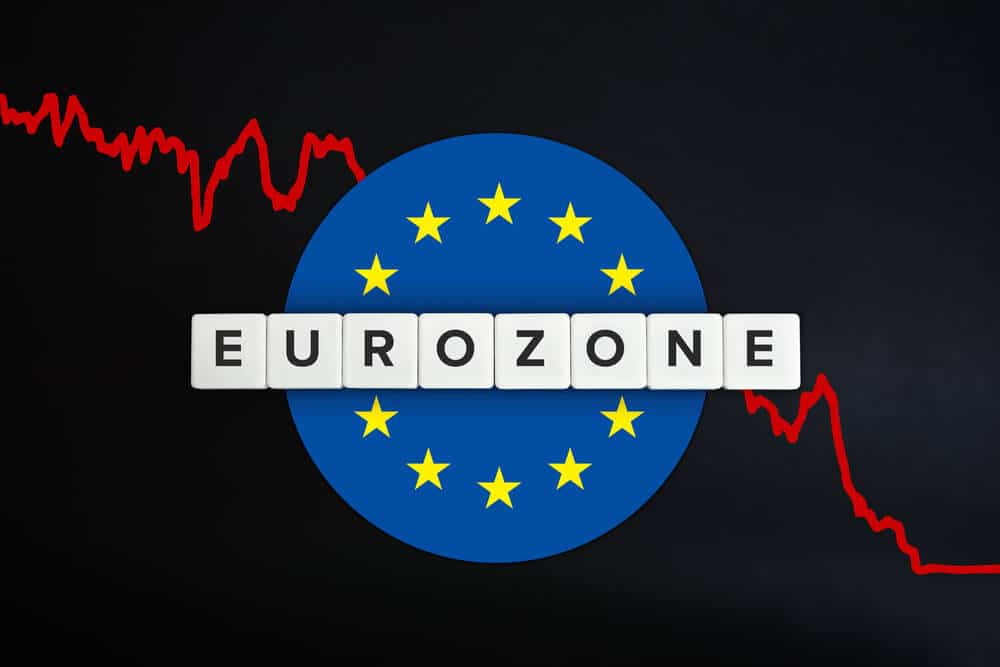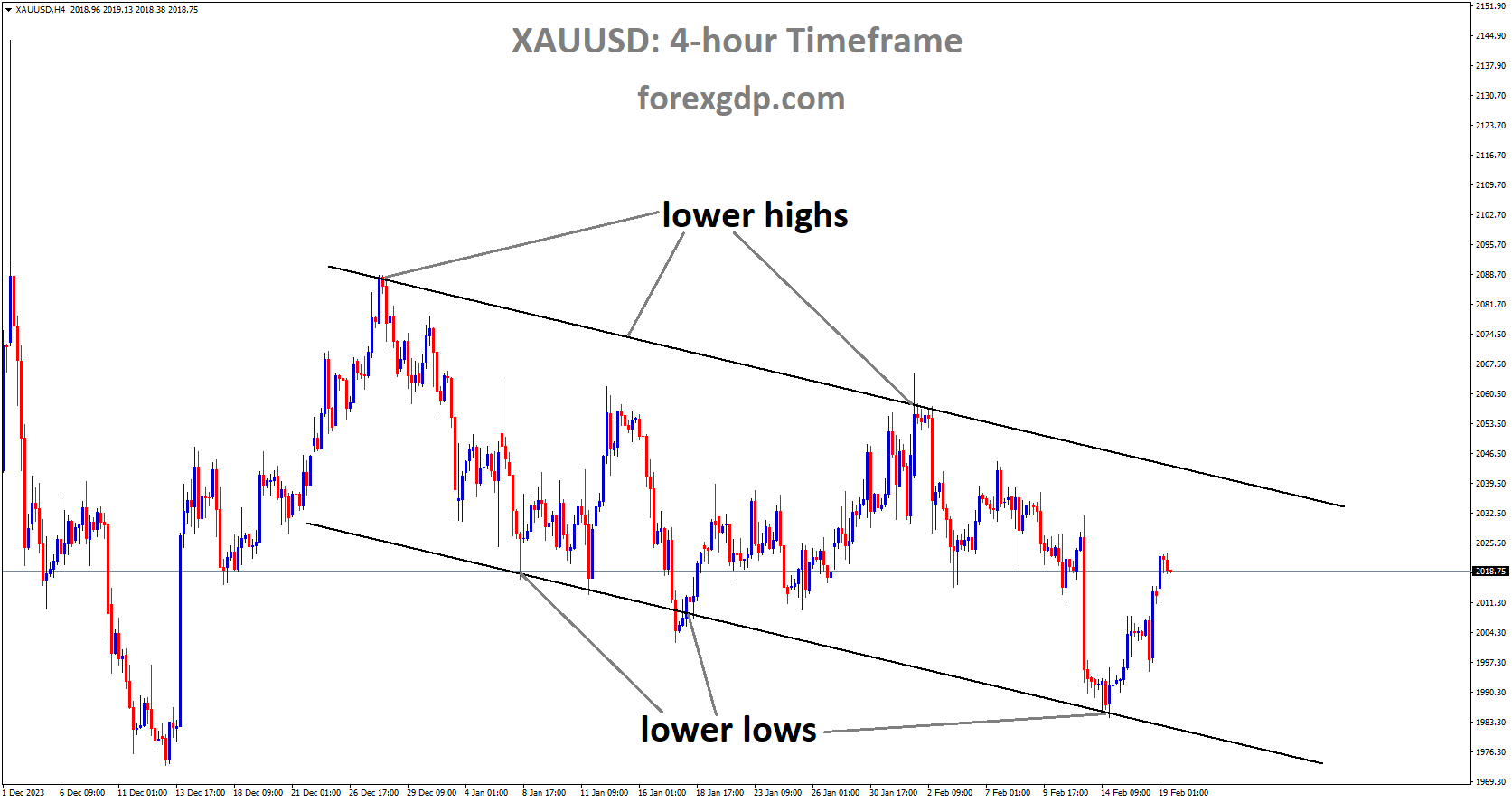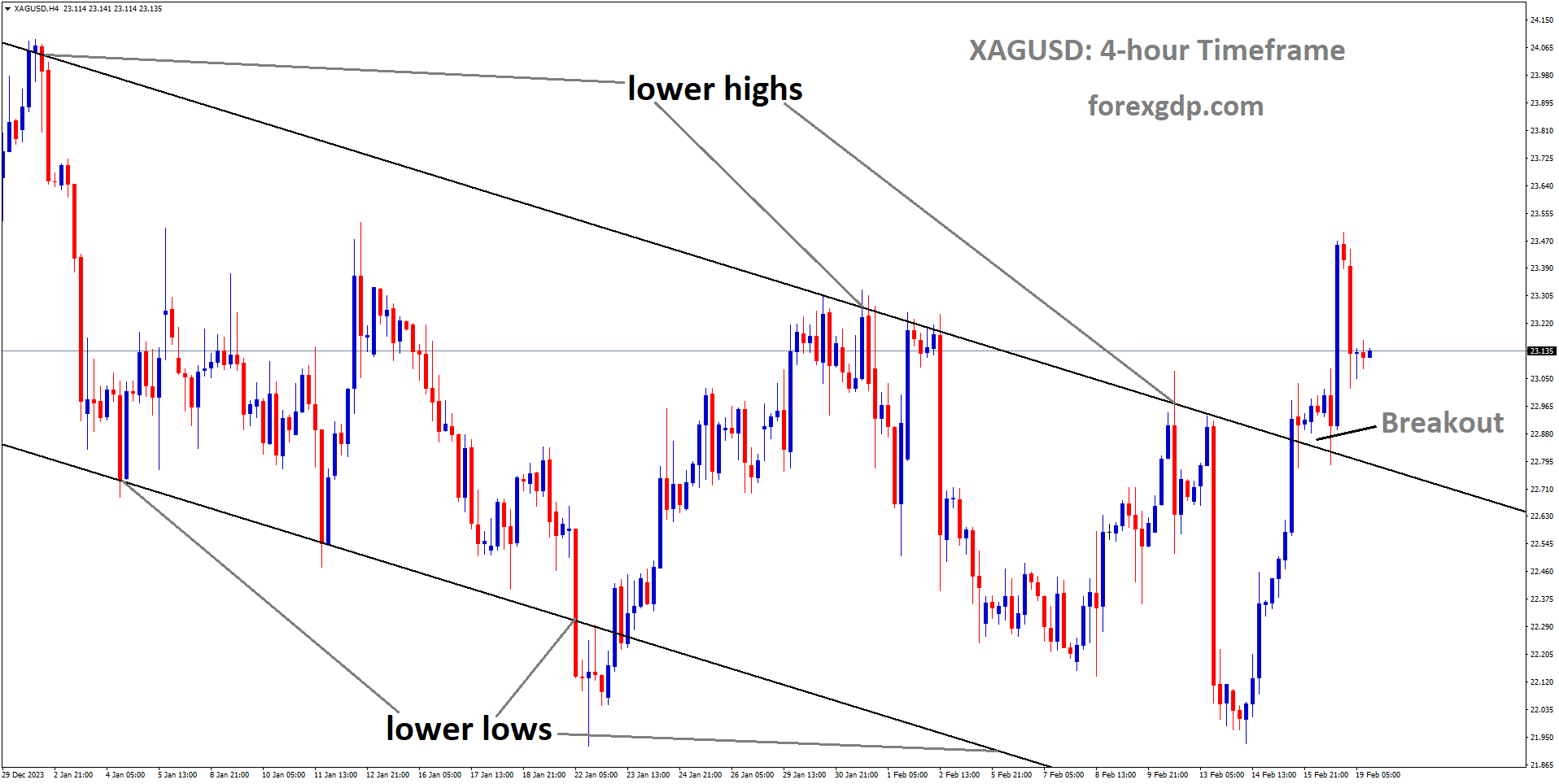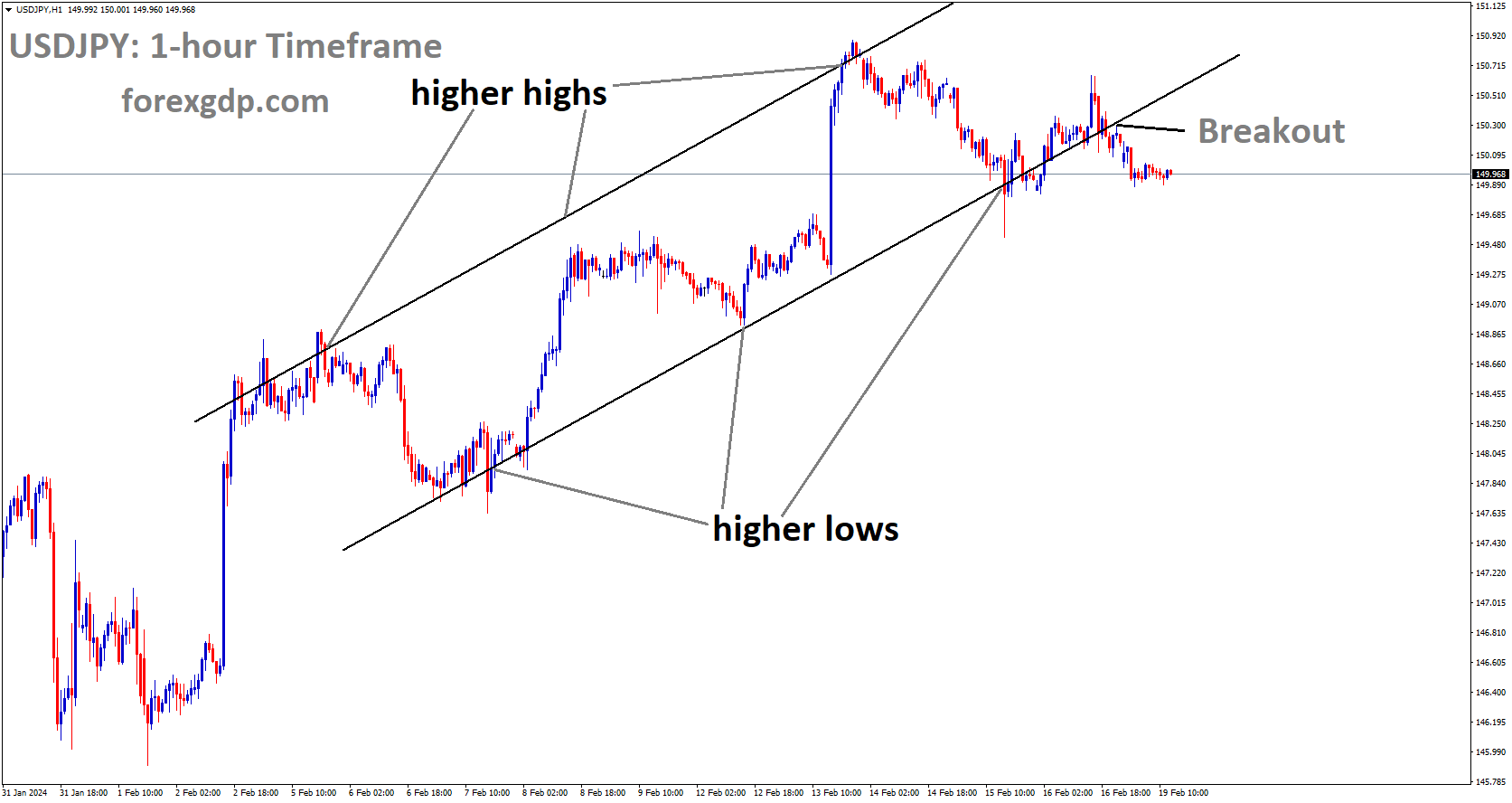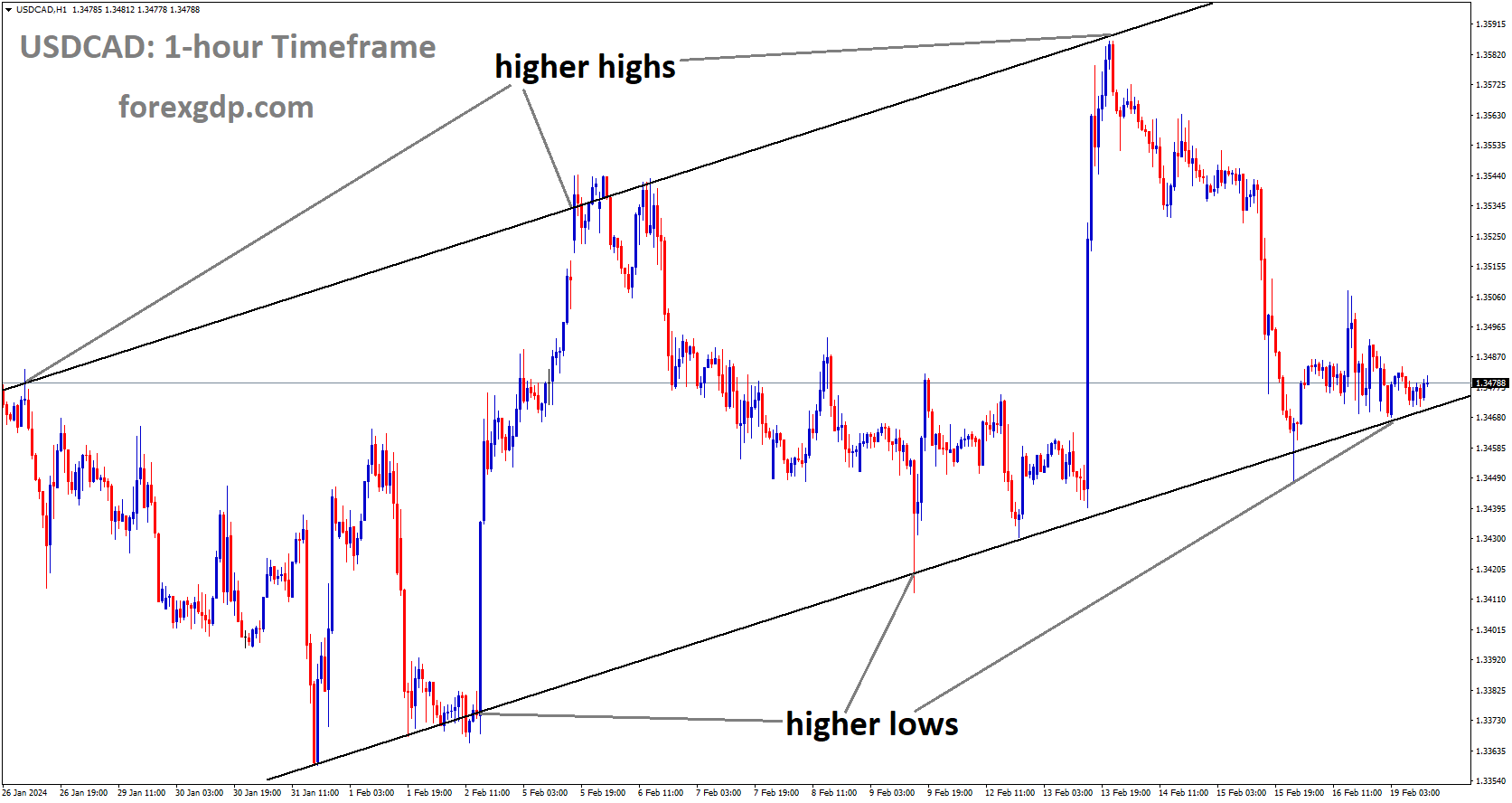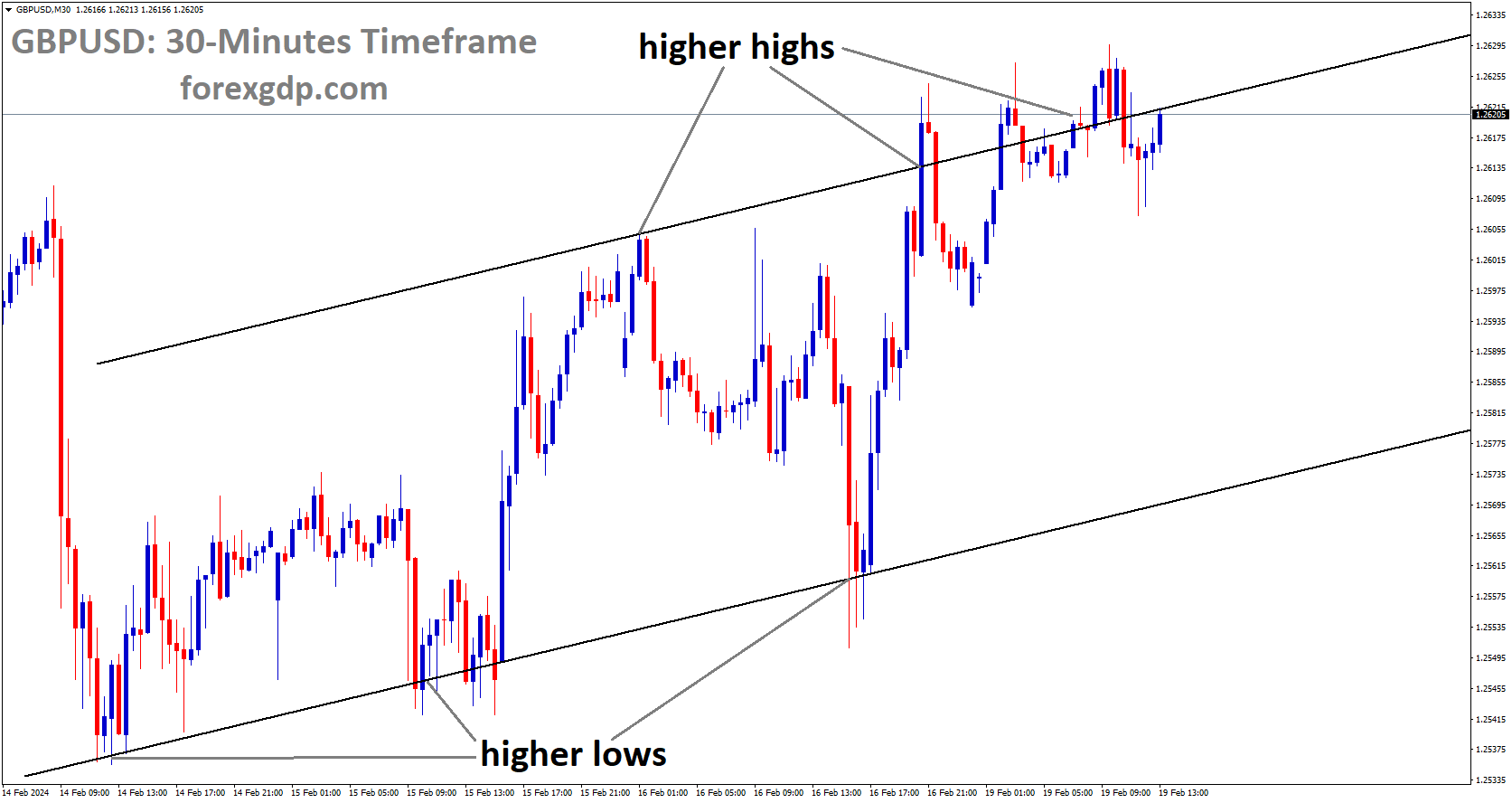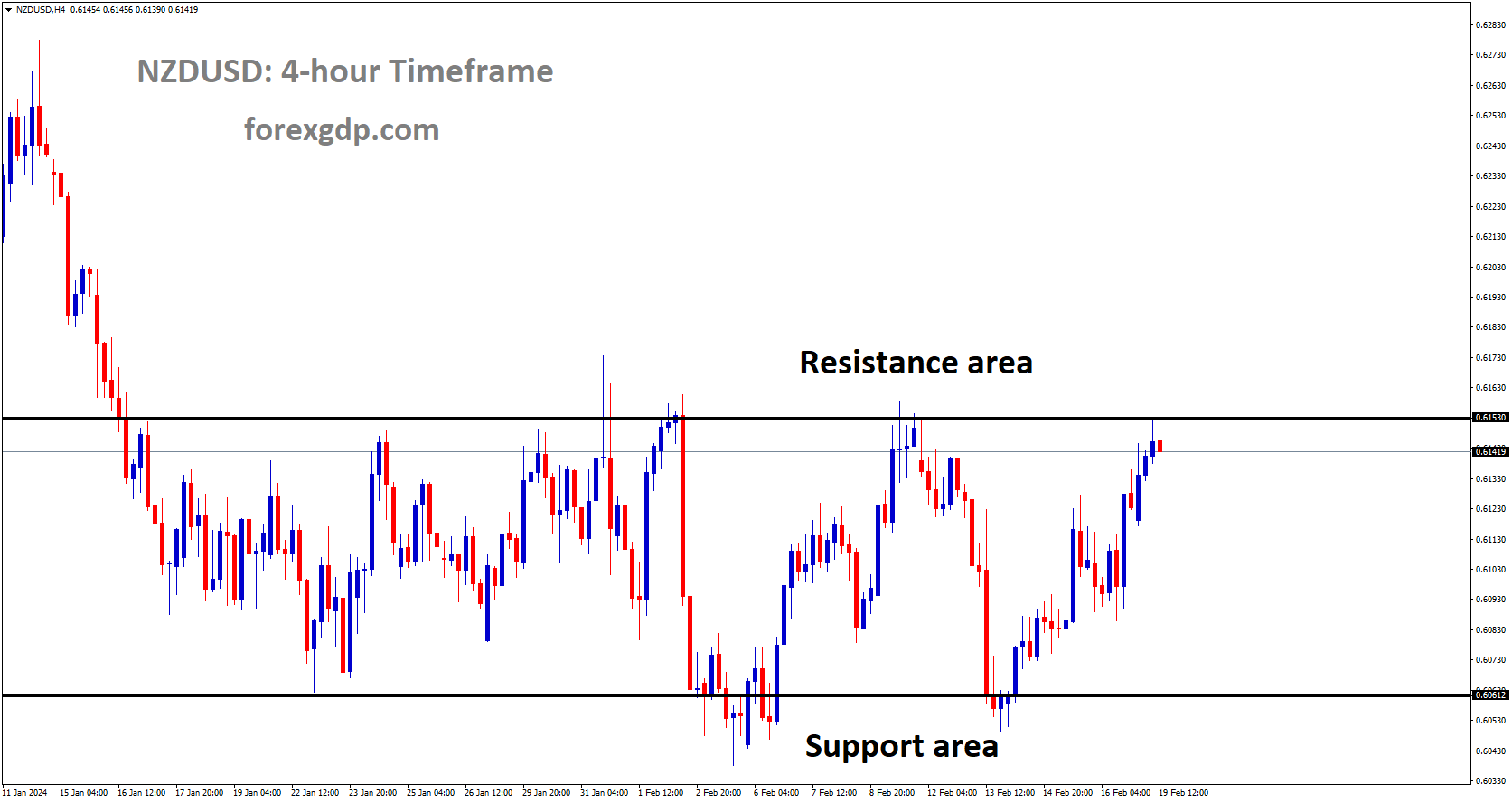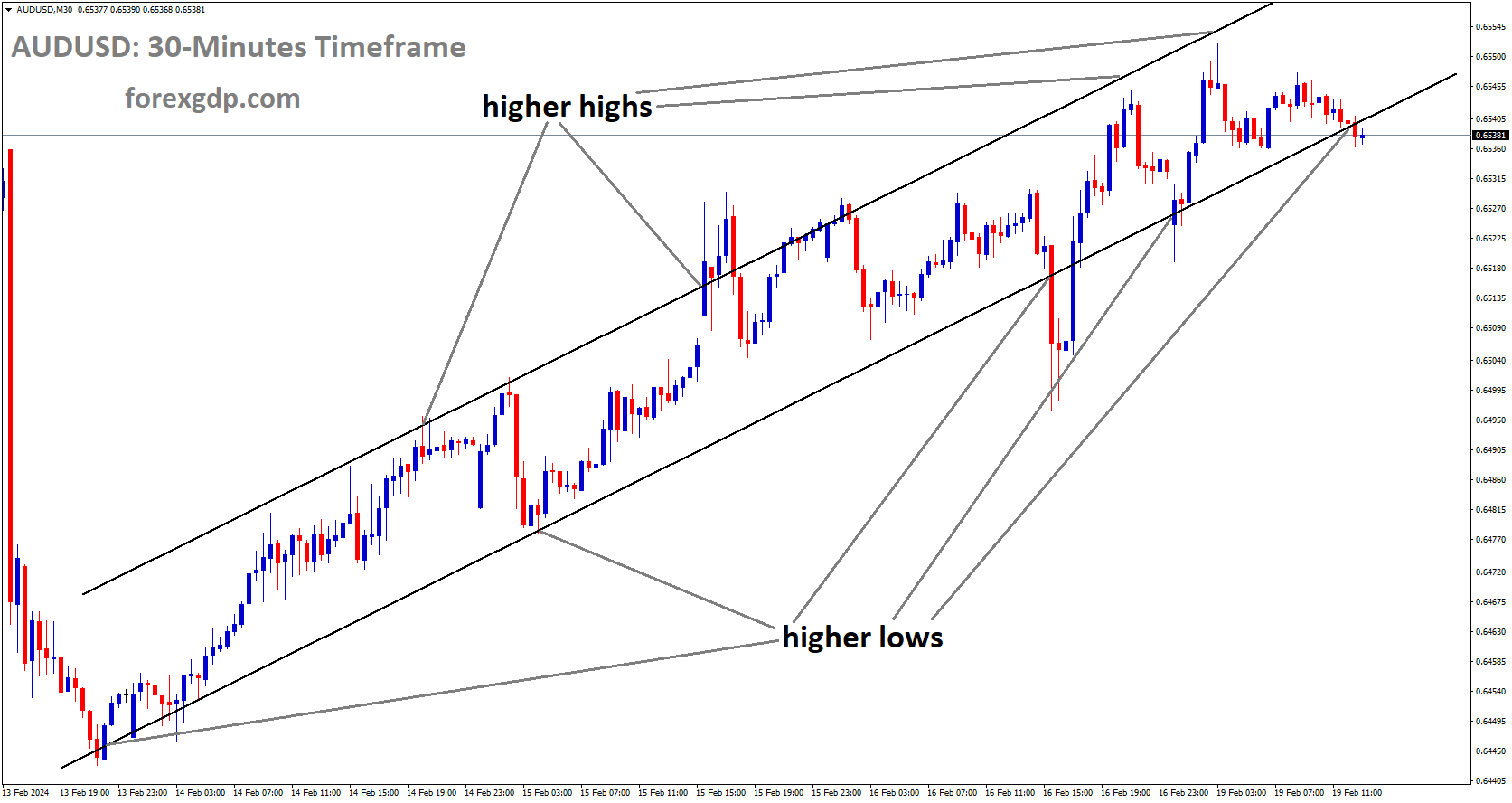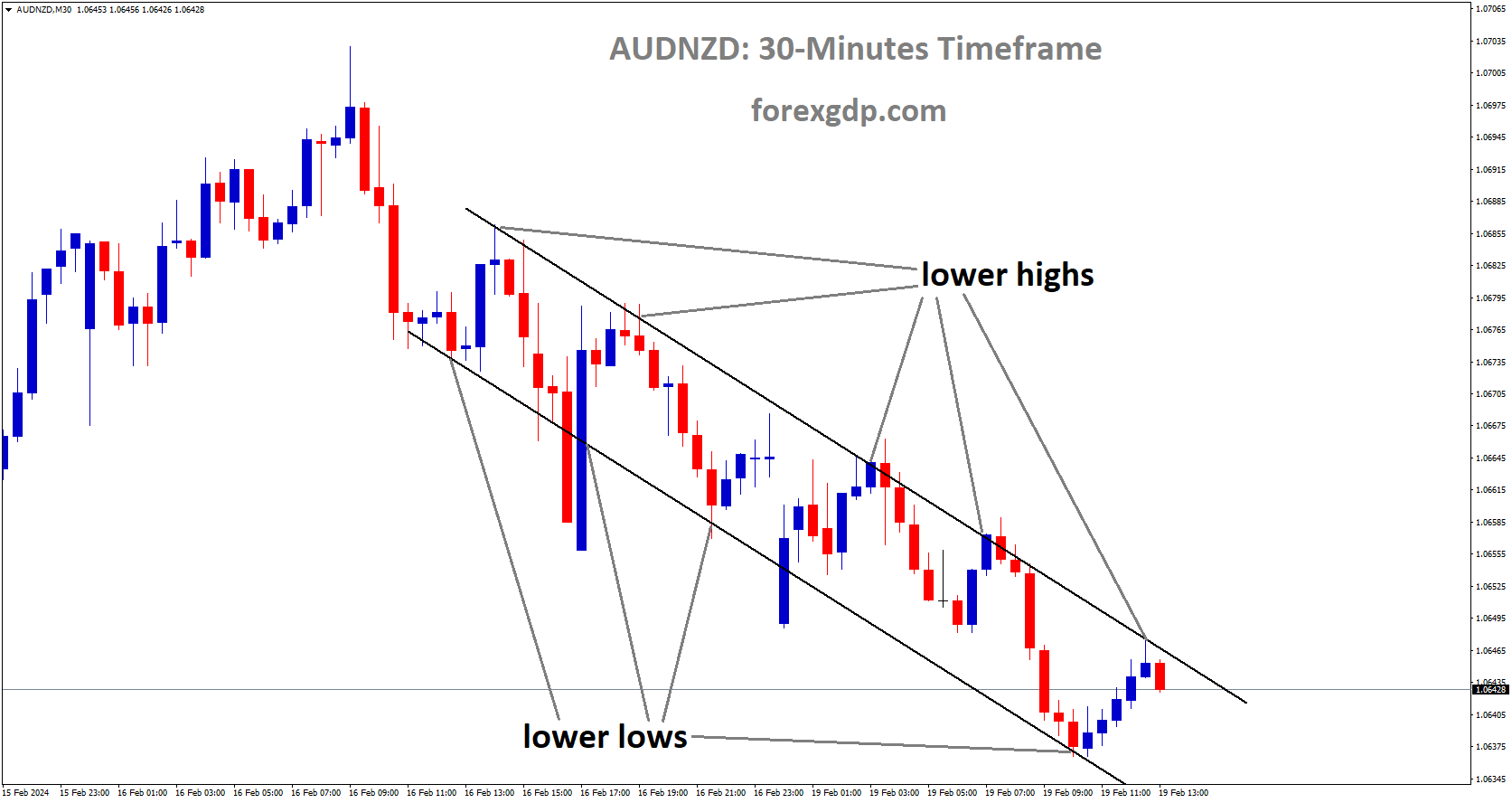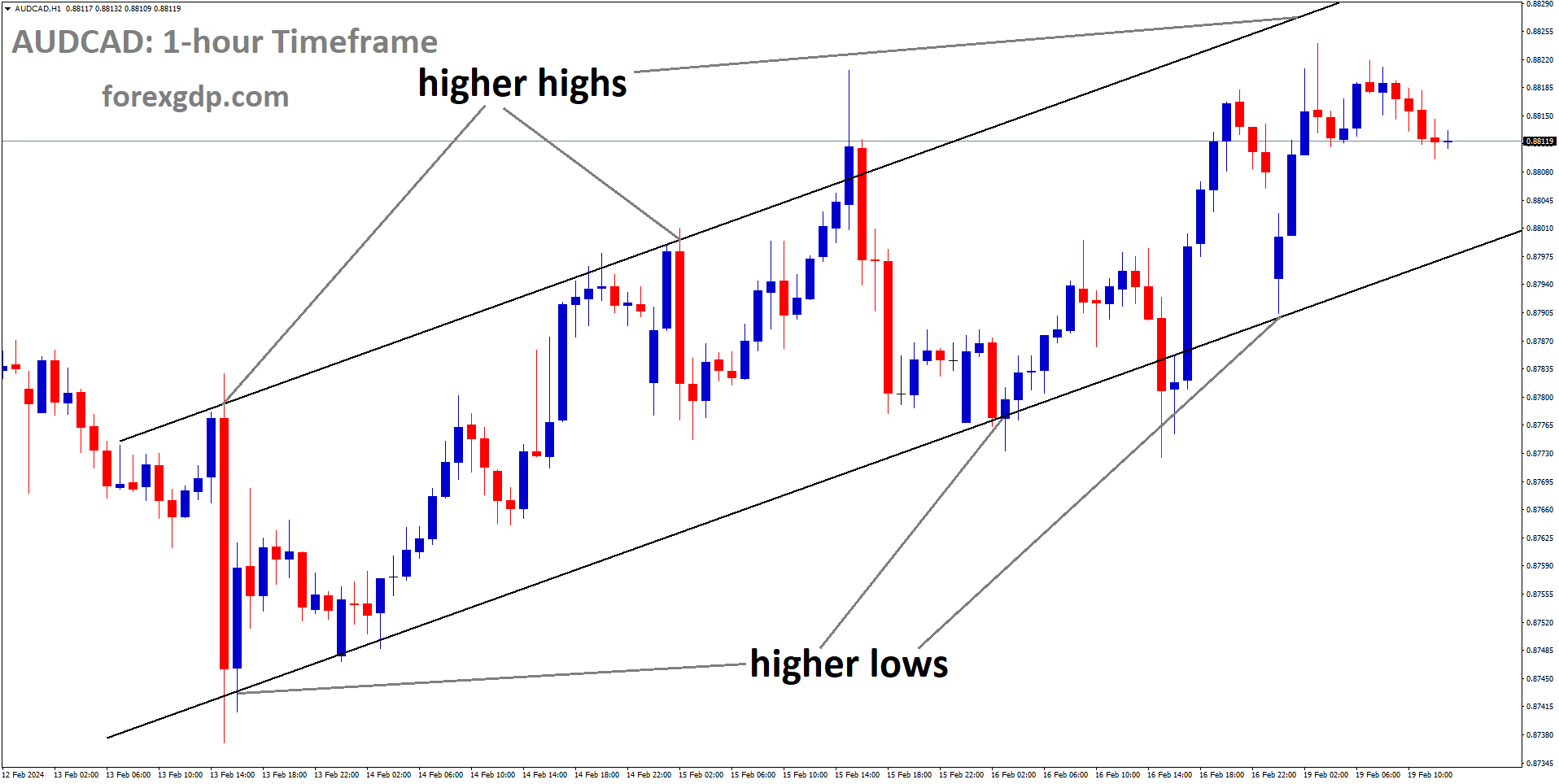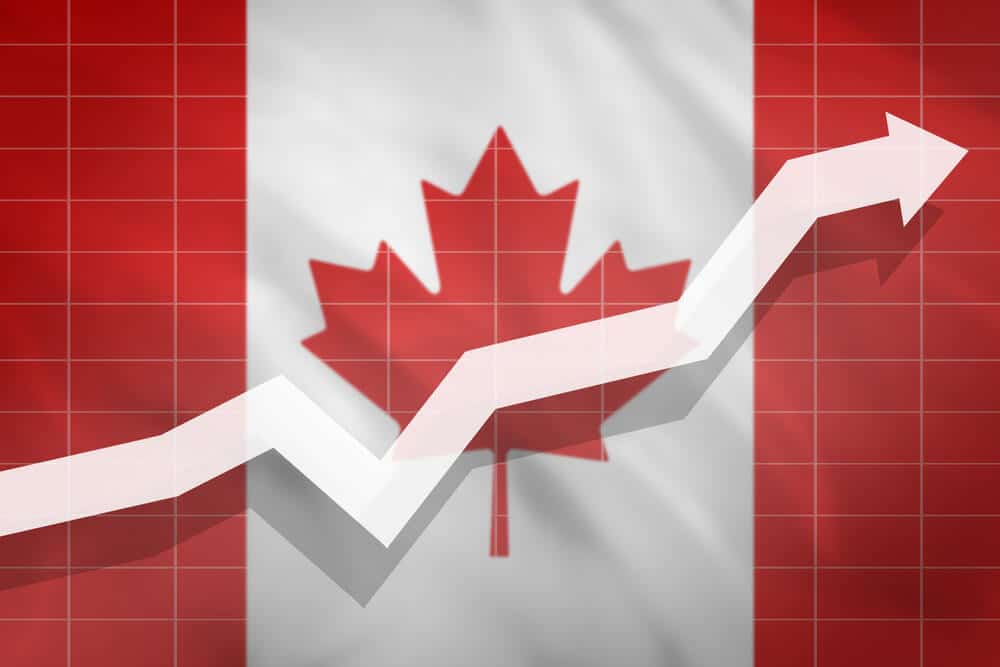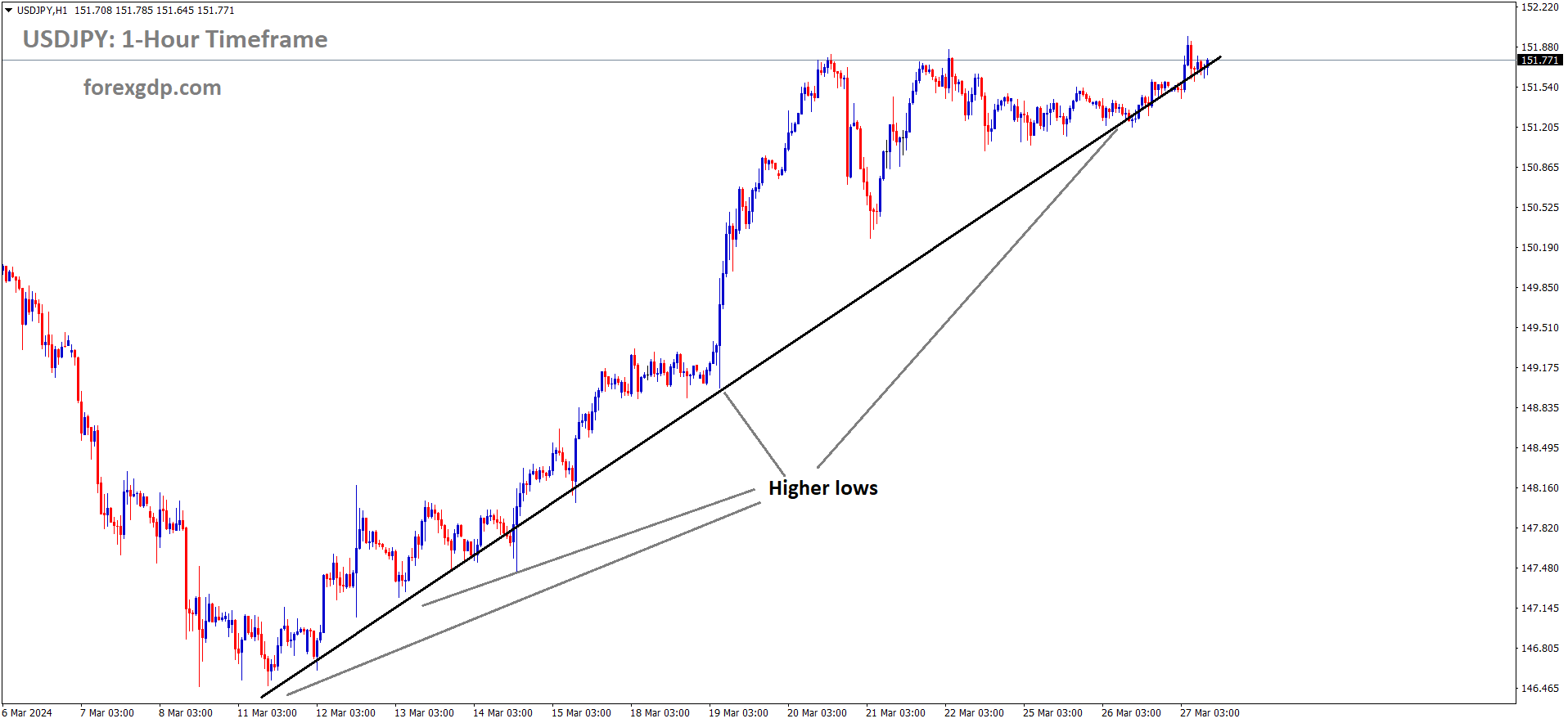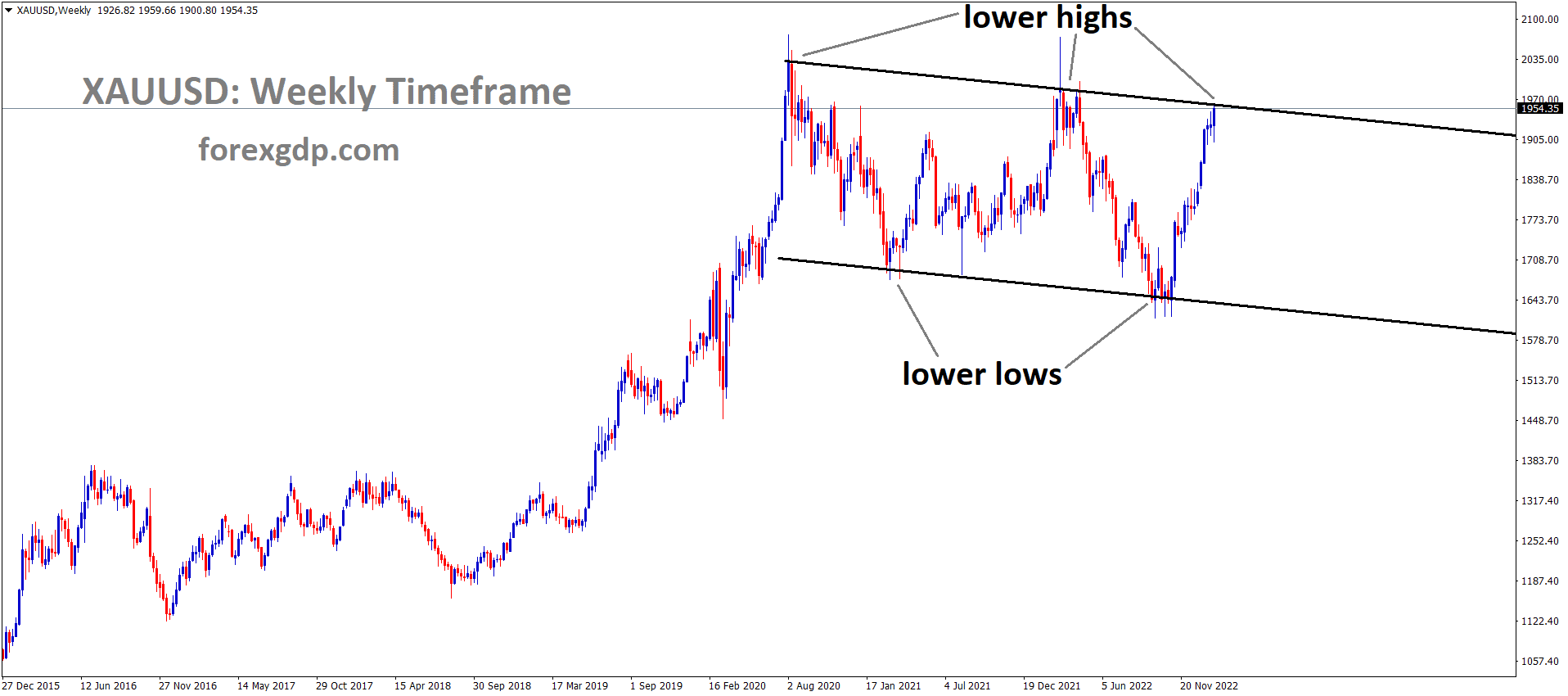EURUSD is moving in Descending channel and market has reached lower high area of the channel
The EUR/USD pair continues to exhibit a sustained bearish bias, maintaining its position below the pivotal 100-period Exponential Moving Average (EMA) on the trading chart. This persistent downward trajectory underscores the prevailing sentiment in the market, indicating a prevailing preference for selling pressure over buying.
EURUSD – Persistent Bearish Bias and Potential Momentum Shift
Reversal in RSI Indicators:
Despite the overarching bearish sentiment, there has been a noteworthy reversal observed in the Relative Strength Index (RSI) indicators. These indicators have climbed back above the crucial 50-midline, suggesting a potential shift in momentum. This reversal hints at the possibility of buyers gaining traction in the near future, potentially influencing market dynamics.
Impact of US Dollar Decline:
The downward movement of the US Dollar has provided some degree of support to the major EUR/USD currency pair. This decline in the value of the Dollar acts as a counterbalancing force to the prevailing bearish sentiment, offering a mitigating factor that could influence the pair’s movement.
Eurozone Inflation Analysis:
Insight from European Central Bank policymakers suggests that Eurozone inflation is on a trajectory towards the targeted 2% level.
However, caution prevails as policymakers emphasize the need for further data confirmation before considering potential rate cuts. This cautious approach introduces an element of uncertainty into the market, impacting traders’ decision-making processes.
Anticipation of Key Data Releases:
Market participants are eagerly awaiting the release of critical data sets, including the FOMC Minutes and Eurozone economic reports such as the Purchasing Managers’ Index (PMI) and Consumer Price Index (CPI) inflation data. These forthcoming releases are expected to provide valuable insights into the inflationary trajectory, potentially influencing market sentiment and guiding trading strategies.
Technical Analysis Insights:
A comprehensive technical analysis reveals the continued dominance of bearish momentum in the EUR/USD pair, as it remains positioned below the significant 100-period Exponential Moving Averages on the four-hour chart. Despite this, the resurgence of the RSI above the 50-midline introduces an element of uncertainty. This suggests that buyers may gain control in the short term, challenging the prevailing bearish sentiment and prompting traders to reassess their strategies accordingly.
GOLD – Key Factors Impacting Gold Prices and Monetary Policy
Producer Price Index Surge:
In January, the US experienced a notable upswing in the Producer Price Index, marking a 0.3% increase compared to the previous month’s slight decline of 0.1%. This surge stands out as the most significant uptick seen since August 2023, indicating potential shifts in the economic landscape.
XAUUSD is moving in Descending channel and market has rebounded from the lower low area of the channel
Geopolitical Unrest’s Influence:
Ongoing tensions in the Middle East hold the potential to sway investor behavior, particularly regarding safe-haven assets like gold. The uncertain geopolitical climate often prompts investors to seek refuge in assets perceived as more stable, such as gold, which could lead to increased demand and higher prices.
Crucial Market Events:
Traders are eagerly awaiting two pivotal events—the interest rate decision from the People’s Bank of China and the release of the Federal Open Market Committee (FOMC) Minutes. These events are poised to provide valuable insights into future market trends, offering potential trading opportunities for investors.
Inflationary Concerns and Fed Policy:
Recent US economic data suggests that inflation may be more persistent than initially anticipated, prompting a reassessment of expectations surrounding the Federal Reserve’s monetary policy.
The diminishing likelihood of interest rate cuts in June reflects this recalibration in market sentiment.
Impact of PPI and Housing Data:
The notable rise in the Producer Price Index for final demand signals potential inflationary pressures within the economy. Additionally, the decline observed in US Housing Starts and Building Permits hints at a potential softening in the housing market, which could have broader economic ramifications.
Interest Rate Effects on Gold:
The delay in anticipated interest rate cuts by the Federal Reserve may influence gold prices. Higher interest rates can diminish the appeal of non-yielding assets like gold, as they increase competition from other investments offering higher returns, potentially impacting gold’s value in the market.
PBoC’s Monetary Policy Outlook:
While no significant policy changes are expected, investors are keen to glean any insights from the People’s Bank of China’s interest rate decision regarding future monetary policy direction and potential stimulus measures.
Middle East Geopolitical Dynamics:
XAGUSD has broken Descending channel in upside
Escalating tensions in the Middle East, coupled with claims from Hezbollah regarding solidarity with Gaza allies, Hamas, add a layer of uncertainty to the global landscape. Such geopolitical unrest often drives demand for safe-haven assets like gold, which could further impact its price trajectory.
Upcoming Market Milestones:
With the anticipation surrounding the PBoC Interest Rate Decision and the release of the FOMC Minutes, traders are gearing up to react to the implications of these events. These releases are expected to shape trading strategies, particularly concerning gold prices, as investors seek to capitalize on emerging market trends.
USDJPY – Retracement and Policy Perspectives
USD/JPY Retracement Amid Dollar Subdued Performance:
The USD/JPY currency pair undergoes a retracement, reflecting a temporary pullback in its recent upward trajectory. This reversal is attributed to the subdued performance of the US Dollar in the forex market, suggesting a potential shift in market sentiment.
USDJPY has broken in Ascending channel in downside
Positive Impact of Japanese Machinery Orders:
The Japanese Yen experiences a boost following the release of better-than-expected Machinery Orders data. This data indicates a notable improvement in business confidence within Japan’s manufacturing industry, contributing to the strengthening of the Japanese currency.
Market Response to US Holiday:
With US markets set to observe Monday as a bank holiday in honor of President’s Day, traders anticipate reduced trading activity and subdued movement in the US Dollar. This holiday-induced lull may temporarily impact currency market dynamics.
USD/JPY Pair’s Movement Dynamics:
Despite the positive performance of Japanese economic indicators, the USD/JPY pair initially sees an uptick driven by impressive US Producer Price Index (PPI) data. However, this upward momentum is tempered following dovish comments from James Bullard, former president of the St. Louis Fed, regarding Federal Reserve policy.
Analysis of Japanese Machinery Orders:
January’s Machinery Orders in Japan register a significant month-on-month increase of 2.7%, surpassing market expectations. This uptick marks a rebound from the previous decline and signals renewed confidence within Japan’s manufacturing sector. Additionally, year-on-year figures show improvement, further bolstering optimism.
Policy Perspectives from Japanese and US Officials:
Japanese Finance Minister Shunichi Suzuki underscores the authority of the Bank of Japan in shaping monetary policy, hinting at potential future adjustments in interest rates. Conversely, James Bullard’s remarks at the National Association for Business Economics (NABE) conference advocate for a cautious approach from the Federal Reserve, suggesting a possible rate reduction in March to mitigate economic risks.
Insights from US Producer Price Index:
Recent data from the US Producer Price Index reveals year-over-year growth surpassing expectations, indicating potential inflationary pressures. Moreover, both annual and monthly improvements in the Core Producer Price Index highlight underlying economic strength in the United States.
Anticipated Market Behavior:
With US banks closed for the President’s Day bank holiday, market participants brace for minimal movement in the US Dollar. This expectation of subdued trading activity prompts traders to adopt a cautious stance in the short term, awaiting clearer signals for market direction.
USDCAD – PPI Movement, Oil Prices, and Policy Outlook
US Producer Price Index (PPI) Upward Movement:
The US Producer Price Index (PPI) surged by 0.3% month-on-month (MoM) in January, marking the most significant increase since August. This uptick contrasts with the previous month’s 0.1% decline, indicating notable movement in the index.
USDCAD is moving in Ascending channel and market has reached higher low area of the channel
Impact of Rising Oil Prices on USD/CAD Dynamics:
The increase in oil prices is poised to bolster the Canadian Dollar (CAD) and pose a challenge for the USD/CAD currency pair. As Canada’s largest oil exporter to the United States, heightened oil prices are likely to exert upward pressure on the CAD and potentially limit the upside potential of the USD/CAD pair.
Market Closures Due to Holidays:
Both US and Canadian markets will remain closed on Monday due to the observance of President’s Day and Family Day, respectively. This holiday-induced closure may lead to subdued trading activity and impact market dynamics during the session.
Anticipation of Canadian Consumer Price Index Data:
Investors are eagerly awaiting the release of the Canadian Consumer Price Index for January, expected to show a slight easing to 3.2% year-on-year (YoY) from 3.4% in December. This data is anticipated to provide insights into inflationary trends in the Canadian economy, influencing market sentiment.
Analysis of US Core PPI Data:
The core PPI, excluding food and energy, also saw a notable increase of 0.5% MoM in January, surpassing expectations for a 0.1% gain. On an annual basis, both the headline and core PPI figures registered rises, indicating persistent inflationary pressures in the US economy.
Implications for Federal Reserve Policy:
The hotter-than-expected PPI report underscores the sticky nature of inflation, potentially prompting the Federal Reserve to delay interest rate cuts. This development has implications for monetary policy decisions and could influence market expectations regarding future Fed actions.
Bank of Canada Policy Outlook:
Bank of Canada deputy governor Toni Gravelle previously indicated expectations to conclude quantitative tightening by late 2024 or early 2025.
However, speculation among short-term traders suggests a possible acceleration of this trend. This uncertainty surrounding policy direction adds complexity to the outlook for the Canadian Dollar.
Upcoming Economic Events:
Market participants will closely monitor upcoming events, including the release of the FOMC Minutes on Wednesday and Canada’s Retail Sales data on Thursday. These events are expected to provide further insights into economic conditions and may drive market movements in the coming days.
GBPUSD – Fed Rate Cut Speculation and UK Housing Data
GBP/USD Retraces Losses Amid Fed Rate Cut Speculation:
The GBP/USD currency pair sees a reversal of recent losses, largely influenced by growing speculation surrounding a potential rate cut by the Federal Reserve in March. This dovish sentiment weighs on the US Dollar (USD), contributing to the upward momentum of the GBP/USD pair.
GBPUSD is moving in Ascending channel and market has reached higher high area of the channel
James Bullard’s Rate Cut Proposal Amplifies Expectations:
Former Federal Reserve official James Bullard’s suggestion for the Federal Open Market Committee to contemplate reducing policy rates in March adds credence to market expectations of imminent monetary policy easing. His remarks, made at the National Association for Business Economics conference, reinforce the prevailing sentiment of accommodative monetary policy ahead.
Positive UK Housing Data Supports GBP/USD Movement:
The GBP/USD pair receives an additional boost from encouraging UK housing data. The UK Rightmove House Price Index (YoY) reveals a modest uptick of 0.1% in February, indicating resilience in domestic property prices. This positive data contributes to the overall bullish trend observed in the GBP/USD pair.
UK Enters Technical Recession Amid Economic Uncertainty:
Amidst these developments, the United Kingdom officially enters a technical recession, characterized by two consecutive quarters of negative GDP growth. This economic backdrop introduces a degree of uncertainty into the market environment, potentially influencing investor sentiment and currency movements.
Bank of England’s Cautionary Approach to Monetary Policy:
Bank of England policymaker Catharine L. Mann underscores the central bank’s cautious approach to monetary policy.
Mann highlights the necessity of acquiring additional inflation data before making any definitive decisions regarding future monetary policy actions. This cautious stance reflects the central bank’s commitment to prudently navigating economic challenges.
Market Response to US Producer Price Index Data:
Despite an initial boost provided by better-than-expected US Producer Price Index (PPI) data, which exceeded market expectations, the US Dollar (USD) ultimately closes the session with losses. This nuanced market reaction underscores the complexities and uncertainties surrounding economic indicators and their impact on currency markets.
NZDUSD – Policy Rate Sensitivity and Global Caution
NZD/USD Sensitivity to Policy Rate Expectations:
Throughout the year, the NZD/USD currency pair has displayed a heightened sensitivity to the ebbs and flows of policy rate expectations. This dynamic has been a significant source of volatility in the currency markets, with fluctuations in expectations directly impacting the movement of the NZD/USD exchange rate. As such, investors closely monitor shifts in policy rate sentiments as they navigate their trading strategies.
NZDUSD is moving in box pattern and market has reached resistance area of the pattern
Expected Support from Higher OCR:
Despite the volatility associated with policy rate expectations, there is an underlying anticipation that a higher Official Cash Rate will act as a stabilizing force for the New Zealand Dollar (Kiwi) in the near term. The OCR plays a crucial role in influencing interest rates and monetary policy decisions in New Zealand. The expectation of a higher OCR suggests a potential strengthening of the Kiwi against its US counterpart, providing support for the currency amid market uncertainties.
Caution Amid Global Risk Environment:
However, amidst ongoing geopolitical tensions and uncertainties on the global stage, caution prevails regarding the overall risk environment. The prominence of geopolitical factors, alongside economic indicators and policy developments, contributes to a complex landscape for investors. Notably, the United States stands out among G10 markets with its cash rate, holding the equal-highest position alongside New Zealand. This underscores the importance of considering global risk factors in assessing currency market dynamics.
USD Stability and Forecast for NZD Appreciation:
Given the prevailing global risk environment and the stability of the US Dollar (USD), forecasts suggest a tempered appreciation of the New Zealand Dollar (NZD) relative to the USD.
While the NZD/USD pair remains influenced by policy rate expectations and other market dynamics, the USD’s resilience is expected to limit significant depreciation. Consequently, analysts anticipate a milder trajectory of NZD appreciation against the USD in the foreseeable future.
AUDUSD – US PPI, RBA Rate Cut Speculation, and AUD/USD Movement
US January PPI Surpasses Expectations:
The latest data on the US Producer Price Index (PPI) for January exceeded market forecasts, showing a notable increase of 0.3% month-on-month (MoM) and a solid 0.9% year-on-year (YoY) growth. This unexpected surge in inflationary indicators suggests a potential uptick in price pressures at the onset of 2024.
AUDUSD is moving in Ascending channel and market has reached higher low area of the channel
Market Speculation on RBA Rate Cut:
There’s growing speculation among financial markets that the Reserve Bank of Australia (RBA) will implement interest rate cuts by the middle of the year. This anticipation influences investor sentiment, particularly evident in the positive performance of the AUD/USD pair during the early Asian trading session.
Boost for AUD/USD from Weakening USD:
The AUD/USD pair starts the week on a positive note, benefitting from the decline in the value of the US Dollar (USD). This downward pressure on the USD contributes to the upward momentum observed in the AUD/USD exchange rate.
Analysis of US PPI Data:
Data released by the US Labor Department underscores the stronger-than-expected performance of the January PPI. The index rose by 0.3% MoM and 0.9% YoY, signaling a notable increase in inflationary pressures. However, the Federal Reserve (Fed) remains cautious, awaiting additional data before considering potential adjustments to interest rates.
Middle East Tensions and AUD/USD Movement:
Escalating tensions in the Middle East, particularly between Hezbollah and Israel, pose a potential challenge for the AUD/USD pair. Heightened geopolitical risks could prompt increased demand for the safe-haven US Dollar, potentially dampening the upward trajectory of the AUD/USD exchange rate.
Expectations for RBA Rate Cut Timing:
Market participants are currently pricing in August as the likely timeframe for RBA interest rate cuts, anticipating that any policy adjustments will follow actions taken by the Federal Reserve.
Despite moderating inflation in Australia, the RBA attributes this trend to factors beyond the scope of monetary policy alone.
Upcoming Economic Events Impacting AUD/USD Pair:
Several key economic events scheduled for the week ahead are poised to influence the AUD/USD pair. These include the release of RBA meeting minutes on Tuesday, FOMC minutes from the January meeting on Wednesday, and the Australian Judo Bank PMI data release on Thursday. Additionally, a speech by FOMC Vice Chair Jefferson on Thursday may provide further insights into monetary policy outlooks, potentially impacting currency movements.
AUDNZD – AUDNZD Outlook, Central Bank Meeting and Rate Cut Expectations
AUD/NZD Shows Weakness as Week Begins:
At the onset of the new trading week, the AUD/NZD currency pair exhibits a slight weakening, reflecting a shift in market attention towards the upcoming release of the Reserve Bank of Australia’s (RBA) February policy meeting minutes. This shift underscores the significance of central bank communications in guiding investor sentiment and currency movements.
AUDNZD is moving in Descending channel and market has reached lower high area of the channel
RBA Keeps Cash Rate Unchanged:
During its February meeting, the RBA opted to maintain its cash rate at 4.35%, a decision largely in line with market expectations. However, despite the decision to hold rates steady, the central bank conveyed a cautious tone regarding potential future policy adjustments, citing concerns over persistent inflationary pressures.
Inflationary Concerns and Policy Guidance:
The RBA highlighted ongoing inflationary pressures, particularly emphasizing the lack of significant decreases in the cost of services. Consequently, policymakers emphasized the importance of being confident in achieving a return of inflation to the target range of 2% to 3% by 2025, with a further aim to reach the midpoint of this range by 2026. These considerations underscore the cautious approach adopted towards monetary policy adjustments.
Anticipation of RBA Meeting Minutes:
Market participants eagerly anticipate the release of the RBA meeting minutes scheduled for Tuesday, as they seek additional insights into the central bank’s deliberations and forward guidance. T
he contents of these minutes are expected to provide valuable clarity on the RBA’s assessment of economic conditions and potential future policy actions, thereby influencing AUD/NZD exchange rate dynamics.
Rate Cut Expectations and Market Sentiment:
Futures markets are currently pricing in a total of 36 basis points of rate cuts by the RBA throughout the year, with a notable focus on the probability of a rate cut in August, estimated at 70%. These market expectations reflect prevailing sentiment regarding the likelihood of monetary policy adjustments by the RBA in response to evolving economic conditions and inflationary trends.
Focus on New Zealand’s Producer Price Inflation Data:
Concurrently, market participants with an interest in the New Zealand Dollar (NZD) will closely monitor the release of New Zealand’s producer price inflation data for the fourth quarter. This economic indicator offers valuable insights into inflationary dynamics within the New Zealand economy, potentially influencing sentiment towards the NZD and its exchange rate performance against other currencies, including the AUD.
AUDCAD – AUD/CAD Outlook: RBA Minutes and CPI Awaited
AUD/CAD Trades Near Two-Week High:
Currently, the AUD/CAD currency pair is hovering close to a recent two-week high, drawing attention from traders and investors who are closely monitoring its movements. This interest is particularly heightened as market participants eagerly await insights from the Reserve Bank of Australia’s (RBA) February policy meeting minutes.
AUDCAD is moving in Ascending channel and market has fallen from the higher high area of the channel
RBA Maintains Cash Rate Stability:
During its February meeting, the RBA opted to keep its cash rate steady at 4.35%, a decision that was largely in line with market expectations. However, despite maintaining the status quo, the central bank issued a cautious reminder that the possibility of further policy tightening cannot be discounted.
Persistent Inflation Concerns and Policy Outlook:
The RBA’s decision to hold rates steady was accompanied by a warning about ongoing inflation concerns. Despite efforts to curb inflation, particularly in the services sector, the RBA highlighted the need for continued vigilance. Policymakers emphasized the importance of instilling confidence in achieving inflation targets, aiming to return inflation to the 2% to 3% range by 2025 and reaching the midpoint by 2026.
Upcoming Release of RBA Meeting Minutes:
Market attention is now firmly focused on the upcoming release of the RBA meeting minutes, scheduled for Tuesday. Traders and investors are eagerly anticipating insights into the central bank’s deliberations and policy outlook, which are expected to provide valuable guidance for AUD/CAD exchange rate movements in the short term.
CAD Traders Await Canada’s CPI Data:
In tandem with developments related to the AUD/CAD pair, traders with positions in the Canadian Dollar are also eagerly awaiting the release of Canada’s Consumer Price Index (CPI) inflation data.
Market expectations suggest that annual consumer inflation likely moderated to 3.2% in January from 3.4% in December. This impending data release holds significant implications for CAD traders, as it offers key insights into inflationary trends within the Canadian economy, potentially influencing CAD exchange rate dynamics.
Don’t trade all the time, trade forex only at the confirmed trade setups.
Get more confirmed trade setups here: forexgdp.com/buy/

